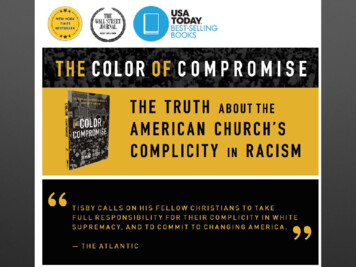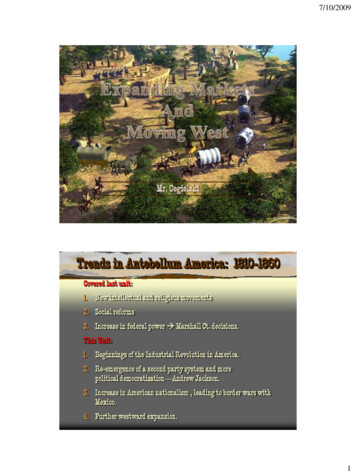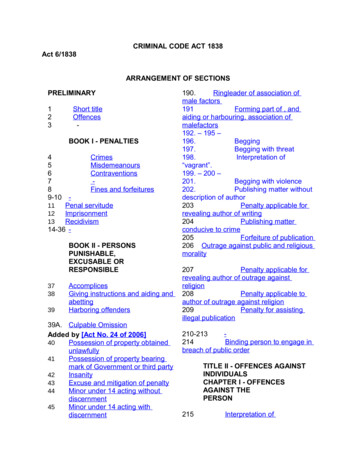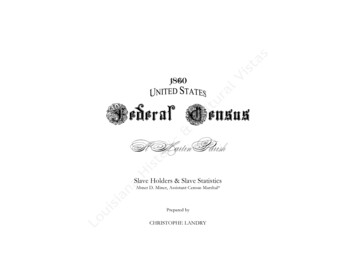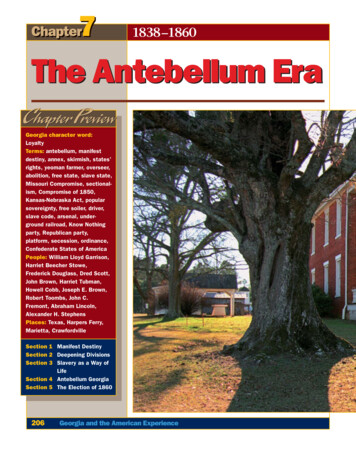
Transcription
1838–1860The Antebellum EraChapter PreviewGeorgia character word:LoyaltyTerms: antebellum, manifestdestiny, annex, skirmish, states’rights, yeoman farmer, overseer,abolition, free state, slave state,Missouri Compromise, sectionalism, Compromise of 1850,Kansas-Nebraska Act, popularsovereignty, free soiler, driver,slave code, arsenal, underground railroad, Know Nothingparty, Republican party,platform, secession, ordinance,Confederate States of AmericaPeople: William Lloyd Garrison,Harriet Beecher Stowe,Frederick Douglass, Dred Scott,John Brown, Harriet Tubman,Howell Cobb, Joseph E. Brown,Robert Toombs, John C.Fremont, Abraham Lincoln,Alexander H. StephensPlaces: Texas, Harpers Ferry,Marietta, CrawfordvilleSection 1 Manifest DestinySection 2 Deepening DivisionsSection 3 Slavery as a Way ofLifeSection 4 Antebellum GeorgiaSection 5 The Election of 1860206Georgia and the American Experience
Historians differ as to the dates that make up theantebellum period (the period before the Civil War).For some, it was 1784 to 1860—the years after theAmerican Revolution. Others set the period as 1823to 1859. For the purpose of this textbook, we will use the periodfrom 1838 to 1860. It was a time filled with turmoil, disagreement, and rapid change.Below: Callaway PlantationHouse. Callaway got the lastshipment of cotton off toEngland before the Civil War.His English broker sold thecotton and banked the money.Callaway used the money tofinish the house in 1869.Chapter 7: The Antebellum Era207
pPP pPSigns of the TimespPpPPp1838-1860Popula1,3ti92on. In:18In 5018,40it ,stoGeodorgatia’90s po6,1pu85lat.ionwas 69theA farmhand in:yrlaaS/segrmfaaW th earned 13 a month, a southern athaorndNortextile operer 22, a maleakmoesha,9 dinary 18, and an oranamseleab 26, anseaman 14.Art/Architecture: Architecture changeddrastically in 1848 when a builder constructed a fivestory building using cast iron girders. The HudsonRiver School style of painting became popular.monic Orchestra, theMusic: The New York Philharorchestra, was founded innation’s oldest symphony1842. Popular songs included “Amazing Grace,”“Michael Row the Boat Ashore,” “Follow the Drinking Gourd,” “Yellow Rose of Texas,” “I’ve BeenWorking on the Railroad,” and “Home on the Range.”Leisure Time:In 1839, Abner Doubledayinlaid out the first baseball diamondeball gamebasfirstCooperstown, New York. TheJersey. Inwas held in 1846 in Hoboken, Newwon a 601851, the schooner-yacht Americayachts. Themile race against four teen Britishrica’s Cup. TedAmetrophy became known as the7.Turner won the America’s Cup in 197208Chapter 7: The Antebellum EraLife Expectancy: In 1850, it was 40 years forwhites and 36 years for slaves.Costs of Living: A night’s stayat atavern cost 50cents; food costaboutcents per pers25on per meal. Awoolen blankecost 2.50. Fltour cost 0.02 a pound, su 0.04 a pound,garand salt 0.06a pound.LiteratuJamrees:FeBonimoksoreof Cothiops peer’rios dTheincludedlayer, Henry DavidPathfinder and The Deersan Melville’s MobyThoreau’s Walden, Hermwthorne’s TheDick, and Nathaniel Haments in printingScarlet Letter. Improvees and newspaperspresses made magaziner of magazinesmore popular. The numb0 in 1800 to overjumped from just over 103,700 by 1860.Fads/Fashions: Fashion arrived inbaseball when the New York Knickerbockersbegan dressing in uniforms in 1851. Matrimonial agencies began to match eligible youngwomen with “deserving” men. P. T. Barnum,known as the Greatest Showman on Earth,opened an exhibit in New York City. Audubonencouraged the fad of birdwatching when hepublished Birds of North America.
PPpScience: Inventions of the period included: Charles Go. ThodeyearTranspd vuorlcataniztiedonrubber in 1839soap powder, the safety pin, the washingmachine, a pencil with an eraser onthe end,and postage stamps with adhesiveon the back.In 1856, Texan Gail Borden receiveda patentfor condensing milk. Oil was usedcommerciallyfor the first time—as medicine. Theintroductionof eyeglasses led some to think theywouldcure the blind.producead linked Chicago to theBaltimore & Ohio Railroce and mail deliveryEast. Stagecoach servid San Francisco, aconnected St. Louis an. In 1860, the Ponydistance of 2,812 milesfrom St. Joseph, MisExpress began servicelifornia.souri, to Sacramento, CaReligion: St. Patrick’s Cathedral of New. Naval Academy openedEducapotilisonin:18Th45e. U.SnThe City of Boston begaYork was designed by James Renwick; today itremains one of the most famous churches inthe nation. Beginning in 1858, religious revivalsswept across the nation with dailyprayermeetings in all major cities.at Annations for elementarygiving written examinatchusetts passed the firschildren. In 1852, Massa8requiring children agesschool attendance lawleast 12 weeks a year.14 to attend school atFigure 17 Timeline: 1840–18601858Georgia’s legislature allocated money tofund free elementary schools1846Georgia sent over 2,000 men to fightin Mexican-American Warp1861Georgiaseceded fromUnion1856Savannah-born John Charles Fremontwas unsuccessful Republicancandidate for president1842Dr. Crawford W.Long of Jeffersonfirst used etheras anesthetic1840PppPpP1849Howell Cobb selected speaker of theU.S. House of Representatives.184518501848Gold discovered in California1850Compromise of 185018551853GadsdenPurchase1854Kansas-Nebraska Act passed;Republican party founded18601857Dred Scottdecision1860Abraham Lincoln elected president;South Carolina secededfrom the UnionSigns of the Times209
Section PreviewAs you read, look for: the concept of manifestdestiny, the westward expansion ofthe United States, and vocabulary terms: manifestdestiny, annex, and skirmish.Below: Revolting againstMexico’s president, SantaAnna, a band of 187 Texiansdefied a Mexican army ofthousands for 12 days. Allof the men were killed, and“Remember the Alamo!”became a rallying cry for theTexian settlers.2101SectionManifest DestinyIn 1845, John O’Sullivan, a New York journalist, wrote that it was the manifest destiny of our country “to overspread the continent allotted by Providence for the free descendants of our yearly multiplying millions.” Withinmonths, what may have seemed to be greed for more land became instead adoctrine backed by religious zeal. In the words of President Polk, who hadbeen elected in part because of his campaign promises to expand U.S. territory, “the world beholds the peaceful triumphs of . . . our emigrants. To usbelongs the duty of protecting them . . . whenever they may be upon oursoil.” And, the hope was that the soil Polk referred to would be Texas, theOregon territory, and California.TexasMexico won its independence from Spain in 1821. Mexican territory included a huge tract of land that started where the Louisiana Purchase ended.The land was called “Texia” by the 30,000 plus Native Americans who livedthere and “Tejax” by the few thousand Mexican Spanish inhabitants. Ledby Stephen Austin, hundreds of white settlers migrated to the region. Theycalled the area “Texas.”Chapter 7: The Antebellum Era
Did You Know?President John Quincy Adams,who had been elected in 1824, triedto buy Texas from Mexico, but heThere were many poplar treeswas refused. After his election inin the San Antonio area.1828, President Jackson also tried toThe Spanish word for poplarbuy Texas. Again, Mexico refused.is Alamo.By 1834, so many “Anglos” hadmoved into the region that they outnumbered the Spanish Mexicans 4to 1. Most of these white settlers refused to obey Mexican laws about slaveryand refused to convert to the Catholic religion. Increasingly, the 20,000 whitecolonists regarded themselves as “Texians” rather than as Mexican subjects.General Antonio López de Santa Anna, who had been elected Mexico’s president in 1833, was increasingly disturbed by the large numbers of white settlers, and he was determined to take control of the Texians. Under a newconstitution, he took away any special privileges in Texas and forbade additional settlers from coming into the area.Furious over these changes, the Texians declared their independence,knowing that a showdown was inevitable. Santa Anna led about 2,000 troopsagainst the rebellious Texians. He quickly took control of San Antonio butwas not able to capture the Alamo, an old Spanish mission where less than190 Texians were determined to make a stand.After a siege of twelve days, Santa Anna’s troops stormed the fort. All ofthe Texas settlers were killed. A few weeks later, Santa Anna ordered the execution of 350 Texians being held at Goliad. Thesetwo incidents inspired the Texians. Two monthslater, Sam Houston led eight hundred men againstSanta Anna at the Battle of San Jacinto. With criesof “Remember the Alamo” and “RememberGoliad” ringing in the air, the Texians defeatedSanta Anna’s army and gained Texas’s independence from Mexico.The people of Texas formed the Republic ofTexas, also known as the Lone Star Republic. Theywanted to become part of the United States asquickly as possible. However, because slavery wasallowed in Texas, it was not until December 1845that it was annexed (added on) and became thetwenty-eighth state in the United States.?Below: Sam Houston led theTexian forces after the Alamoand Goliad. Bottom: “Newsfrom the Mexican War Front”shows how interested peoplewere in the war.The Mexican-American WarAfter the annexation of Texas, Mexico angrily cutoff all diplomatic ties with the United States. To addinsult to injury, U.S. officials demanded that the RioGrande be the southern border of Texas. As skirmishes (minor, short-term battles) broke out, President James Polk offered to buy California and NewSection 1: Manifest Destiny211
Mexico and to take on Mexico’s debt in order to keep the Rio Grande as theborder. Mexico’s response was an invasion of Texas.Polk sent General Zachary Taylor and 3,500 troops to observe the happenings along the Rio Grande. After several of Taylor’s men were killed inwhat some called a staged provocation of the small Mexican army, Polk askedCongress to declare war on Mexico.The first time the two nations met was at Palo Alto, and the battle provided an indication of what was to come. Taylor, called “Old Rough andReady” by his troops, easily defeated a force twice his size. Then in a followup campaign, 1,700 U.S. troops defeated a Mexican force of 4,500.American losses in both battles were50 men; Mexican losses totaled moreAs American soldiersthan 1,000.marched across the dry, dustyIn September 1847, after sixland, they were covered withmonths of hard fighting and as thea thin white film thatwar drew to a close, General Winfieldresembled Mexican adobe.Scott led 7,000 troops to Mexico City.The Mexican soldiers nickThere they were met by about 1,100named the American troopsMexican troops and a small group of“dobies” or “doughboys.”cadets who attended the militaryThat name stuck for the nextacademy at Chapultepec Castle.one hundred years.Ordered by their commandant toleave, the cadets—boys between theDid You Know?Top: The Battle of Chapultepec Castle was the lastbattle of the MexicanAmerican War. Above: In thewar, General Zachary Taylorwon major victories atMonterrey and Buena Vista.212Chapter 7: The Antebellum Era?
ages of 13 and 17—instead joined the battle. One of the cadets, Juan Escutia,died clutching the Mexican flag to keep it away from American troops. InMexican history, these cadets are referred to as “Los Niños Heroes,” or theboy heroes of Chapultepec. The event is lovingly commemorated by citizens of Mexico each September 13.After American forces took Mexico City, the two countries signed the Treatyof Guadalupe Hidalgo. The treaty gave the United States more than 500,000square miles of territory, which today includes California, Nevada, Utah,Arizona, most of New Mexico, and parts of Wyoming and Colorado. Mexicoagreed to drop its claims on Texas lands at the Rio Grande. In turn, Polk agreedto pay Mexico 18.25 million, about 20 percent less than he had originallyoffered for the land. More than 112,000 Americans fought in the war, including over 2,100 Georgians. Although over 1,500 soldiers died in battle,more than 12,000 American soldiers died from diseases and accidents.In 1853, through the Gadsden Purchase, the United States obtained thesouthern part of New Mexico for 10 million. With that purchase, thecountry’s continental boundaries ran from coast to coast.Above: President Polkbelieved in manifest destinyand added a vast area to thenation.OregonAnother land area wanted by theUnited States was the Oregon TerriOREGONTERRITORYCEDED BYtory. This region was west of theGREAT BRITAIN18461818Rocky Mountains and north of California. It stretched northward to 54 LOUISIANA40' north latitude, which today isMEXICANPURCHASECESSIONBritish Columbia’s northern border.18031848Great Britain and the United Stateshad an ongoing dispute over thelocation of the boundary line beTEXASANNEXATIONtween Canada and the UnitedGADSDEN1845PURCHASEStates. Americans claimed it should1853be drawn at 54 40' north latitude.The British disagreed, and war wasa possibility.In a 1818 treaty, the United States and Great Britain had set the boundarybetween the United States and Canada at the 49th parallel (49 north latitude) westward from the Lake of the Woods (in Minnesota) to the Continental Divide. (The Continental Divide is a series of mountain ridges fromAlaska to Mexico that divides the areas drained by different river systems.)After many negotiations, the two countries agreed to split the Oregon Territory by extending the border along the 49th parallel to the Pacific coast.ORIGINALUNITEDSTATESFLORIDACESSION1819Map 30Expansion of theUnited StatesMap Skill: What stateswere included—in total orin part—in the OregonTerritory?CaliforniaWhen the Mexican-American War was over, America’s borders stretchedfrom the Atlantic to the Pacific. Thousands of pioneers heeded Horace Greeley’sadvice of “Go west, young man” and moved into the new territories. Theirreasons for moving west were many. Some wanted adventure; some wereSection 1: Manifest Destiny213
Above: Those who came tomine for California’s goldwere called “forty-niners.”It’s Your Turn1. What was the concept ofmanifest destiny?2. Did Santa Anna havereason to be angry withthe Texians? How wouldyour life be differenttoday if Texas hadremained a part ofMexico?3. What boundary disputewas reflected by thecampaign slogan “54-40or fight”?t214looking for riches. Many wanted new lands for farming, mining, or trapping.Some, such as the Mormons, were escaping religious persecution; others justwanted to escape the overcrowded cities of the East.The Oregon and Santa Fe trails were the favored routes west. Settlers rodemonths in covered wagons across barren and hostile lands facing Indianattacks, severe weather, the harsh Rocky Mountains, and frontier hardships.Many died along the way and were buried beneath the hardpacked trails.But none of these hardships stopped thousands from leaving hearth andhome once they heard the word gold.In 1829, gold had been discovered in Dahlonega, creating the country’s firstgold rush. Twenty years later, an even greater gold rush took place. In January1848, John Marshall was building a lumber mill for John Sutter on California’sAmerican Fork River. He discovered something shiny in the river. Marshall haddiscovered the gold in the California hills. The two men tried to keep the discovery secret, but word got out. In December 1848, President James Polk confirmed the presence of gold, and a national stampede toward California gotunderway. People traveled in wagon trails, on horseback, and on foot to reachthe gold fields. They came not just from the eastern United States but also byship around the Cape of Good Horn and by mule trains from Panama. Mining camps sprang up overnight as over 80,000 people rushed into California.Between 1848 and 1850, the population of the area increased tenfold. Manywho traveled west in search of riches never found any gold, but they stayed tosettle the frontier territory trapping, ranching, and farming.Chapter 7: The Antebellum Era
2SectionSection PreviewDeepening DivisionsAs you read, look for: the differences betweenNorth and South during theantebellum period, southern class structure, slavery and the compromisesmade in the 1800s, differences between theeconomies of the North andSouth, and, vocabulary terms: states’rights, yeoman farmer, overseer,abolition, free state, slave state,Missouri Compromise, sectionalism, Compromise of 1850,Kansas-Nebraska Act, popularsovereignty, and free soiler.During the antebellum period, the nation was basically divided into foursections. Among these four sections were political, economic, social, andcultural differences as well as some specific cause-and-effect events.While the western territorial boundaries were expanding, differences between the other sections of the country were intensifying, particularly between the North and the South. Look at Figure 18 on page 216 to get an ideaof how these differences eventually led to war.States’ RightsProbably the simplest or at least the clearest difference between the Northand South involved the concept of states’ rights. States’ rights is the beliefthat the state’s interests should take precedence over the interests of thenational government.Northern states believed that, in order for the United States to function asone Union, political decisions should be made that would benefit the entirecountry. They believed that all states should abide by laws made by Congress, signed by the president, ordecreed by the courts.Southern states, on the otherhand, believed deeply in the ideaOREGONCOUNTRYof states’ rights. They thoughtthat states had the right to governthemselves and to decide whatUNORGANIZEDTERRITORYwould be best for their own needsand situation. They believed thatCLAIMEDpoliticians from a state like MaineBY MEXICOor New York could not possiblyunderstand or care about SouthCarolina or INMDDEVAMOKYNCTNARSCMSALGALALOUISIANAFree StatesClass StructureFLA.TERR.Slave StatesBorder StatesAs Figure 18 indicates, classstructure in the North was generally based on wealth. That wealth allowed people to move upward from onesocial class to another. In the South, however, the social structure was basedmore on class and, even though that included money, being “born into theright family.” Southern class differences were quite rigid, and it was far moredifficult to move upward from one group to another.Although there had been a highly defined social structure in America sinceits beginnings, it became even more rigid during the antebellum era. Georgia’ssocial structure mirrored that of the other southern states.Map 31AntebellumAmericaMap Skill: What were thefour border states?Section 2: Deepening Divisions215
Figure 18 North-South DifferencesIssueNorthSouthSlaveryWanted to abolish slavery.Supported slavery.States’ rightsBelieved in a strong nationalgovernment.Believed that states had the right to rulethemselves.EconomyBased on factories, mining, banks,stores, and railroads.Based on agriculture, including cotton,tobacco, and rice. Cotton was shippednorth to make cloth and thread.TariffsFavored high tariffs on goods fromother countries so goods manufacturedin North cost less and would outsellforeign goods.Favored low tariffs because they boughtso many goods from other countries.CultureHad a number of large cities offeringmuseums, opera, lectures, theaters.Had few large cities other than Richmond,Charleston, Savannah, Augusta.EducationMany private schools, including churchsponsored schools, accepted both boysand girls. Some public schools wereopen to both. Private universities suchas Brown, Harvard, Yale were opening.No formal educational system in theSouth. Private tutors or school abroadwere options for upper class. Somecommunity schools but teachers werenot usually trained. Some statechartered universities such as Universityof Georgia, University of North Carolina,and some private schools such asSuwanee (University of the South).SectionalismNorthern states believed that theirstand against slavery and their concernsover tariffs, culture and lifestyle madethem the favored, and therefore best,section of the country.Southern states believed that their standon slavery was just, their concerns overtariffs were fair, and their culture andlifestyle were to be treasured. Theybelieved in the rights of states todetermine their own destiny. They knewtheir section of the country was best.216Chapter 7: The Antebellum Era
PlantersPlanters were divided into twocategories—large and small. Ownersof large plantations were those whoowned over fifty slaves and over onethousand acres of land. By 1860, although they represented less than 1percent of white families, planterswere the wealthiest people in theUnited States. Their lives were filledwith luxury in magnificently builtmansions.Planters and their families tookpart in parties, dance balls, picnics,rides in the country, horse races, finedining with elegant wines, andweek-long house parties. Furniturewas imported from Great Britain orspecially made for their mansions.Fine day clothes were imported orhand-sewn, and evening dress wasmost elegant. Each household member, from newborn to master of theplantation, had a slave who servedhis or her needs—from helping tobathe and dress them, to providinghair dressings or make-up, to bringing refreshments. There were evenslaves, usually youngsters, whostood near dining tables and wavedlarge fans during meals and slaveswho nursed newborns.Owners of small plantationsowned between twenty and fortynine slaves and between one hundred and one thousand acres. Theymade up about 3 percent of thewhite southern families. They controlled most of the wealth in theSouth and produced most of its political leaders. Their homes, although notas lavish as the larger plantation homes, were still elegant. In the larger cities, like Athens, Augusta, Macon, and Savannah, their favorite entertainmentswere theaters, trading shows, and lectures.Above: The dining room ofthe Dickey House, built in1840, is a typical plantationhome. It was moved to StoneMountain Park in 1961.Farmers with SlavesFarmers who owned fewer than twenty slaves were about 20 percent ofthe southern whites. Most of these farmers owned five or fewer slaves. TheySection 2: Deepening Divisions217
Figure 19Southern mallFarmers with SlavesDid You Know?made up the small middle classaround towns and cities. The headof the household took a direct, dayAccording to the 1860to-day approach to running thecensus,there were 118,000farm. Homes were comfortable butwhite families in Georgia. Ofnot nearly the size of plantationthese, only 41,084 families,mansions. Women of the house usuor 35 percent, owned slaves.ally worked side-by-side with ahousehold servant. Parties were onlyheld around holidays and specialoccasions and included close family and friends. Food and clothes weresimpler although adequate, and there was little intermingling with theplanter class.?Merchants and “People of Letters”Merchants andPeople of “Letters”Yeoman Farmersand Poor WhitesFree BlacksSlavesMembers of this class were primarily located in towns and cities. The groupincluded cotton brokers, merchants, teachers, doctors, ministers, newspaper publishers, and lawyers. They made up about 1-2 percent of the population of a city. Many merchants were wealthy and lived in fine brick homeswith gardens. They were usually quite knowledgeable about the workings oftheir city or town. They tended to socialize among their own group andenjoyed a very good life.Within the merchant group were the artisans, people who depended ontheir own talents and recognition. Artisans kept to themselves within theirsocial class. Some artisans, such as carpenters, bricklayers, millwrights (thosewho put up mills), saddlers, shoemakers, and milliners were considered tobe in the same class as yeoman farmers. Others, such as furniture designersand makers, landscapers, and portrait painters were in the same social classas merchants.Yeoman Farmers and Poor WhitesYeoman farmers were by far the largest group of white southerners,making up about 75 percent of the white population. These were independent farmers who often lived from season to season. Many were subsistencefarmers, who literally lived off the land with almost no cash money. Whatthey needed, they grew or made or got by trading their own goods or homemade products. Overseers (persons hired to manage slaves on a day-to-daybasis) were usually considered part of this class. Some of the “better off” yeoman farmers did have a few slaves, but the majority scrambled just to ekeout a living.Life was very hard, and homes were usually unpainted wood cabins oreven shacks. Food consisted of what could be raised, traded, or hunted. Theirwork days ran from “sun up to sun down,” and children also worked. Manychildren ran about barefoot and usually had only two outfits. Leisure timewas largely a daydream.Poor whites were the poorest yeoman farmers and might be squatters, daylaborers, or those who simply wandered from place to place seeking jobs,218Chapter 7: The Antebellum Era
Left: The Rufus T. SmithHouse, built in the 1850s andnow at the Thomas CountyMuseum of History. Smithwas a yeoman farmer whoowned no slaves. He did,however, have 13 children.Figure 20Slaves’ SocialLadderfood, and clothes. This group included those known primarily as “whitetrash.” They seldom worked and depended upon others for survival.Free BlacksFree blacks included farmers, day laborers, artisans, or tenant farmers; theywere concentrated in the upper South in Maryland and Virginia. A few freeblacks owned slaves and small plantations or large farms, but they could notmove in the same social circles as their white counterparts. Free blacks wholived in the South were about 6 percent of the total free black populationof 500,000.Although free in name, they were denied most citizenship rights, and inonly two northern states did they have the right to vote. They could not layclaim to public land, travel abroad, or even travel freely in the United Stateswithout a pass. In most places, they could not get an education. And, regardless of the state, they were relegated to segregated neighborhoods. Inthe South, free blacks primarily socialized only with each other.ButlerorPlantersmanservantlarge and smallCoach Driver/DoormanLadies Maid andDresserCookHousehold MaidsSlavesSlaves were about 4 million of the total black population in the countryin the 1860s. By far, the majority lived in the South, and by 1860, about11.5 percent of the slaves lived in Georgia.There were classes of slaves, which, on some plantations, were as rigidas the class structure among whites.Skin color made a difference in theslave social structure. Slaves withlighter complexions often had posiIn 1860, there were 3,500tions inside the plantation house,free blacks living in Georgia.which meant better clothes or handme-downs, food, and huts.Slave DriverField HandsDid You Know?Section 2: Deepening Divisions219
The Issue of SlaveryFigure 21 Cotton Production andSlave Population, 1800-18604,000,0003,500,0003,000,0002,500,000Slave 8101820The most divisive issue that ledto the Civil War was the question ofslavery. Did one man have the rightto own another? In order to answerthat question, let us first look backin history.Much of the antebellum periodwas about “cause and effect,” theconcept that for each event or thingthat happens, there is a cause. In turn,each cause leads to a result, or effect.Then, that result can cause anotherevent, resulting in a chain reaction ofcause-and-effect relationships. Several events from the past directly impacted the antebellum period.By 1800, the South was stagnant(not growing or changing) both interms of population growth and agriculture. Tobacco had depleted thesoil in Virginia and North Carolina.Cotton Production,Rice could only be grown in thein Balescoastal areas of South Carolina andGeorgia. And cotton was not cost effective. But Eli Whitney’s cotton gingreatly increased the profits of growing cotton in the South. In turn, that1830184018501860led to a dramatic increase in the numbers of slaves needed to cultivate“King Cotton.” By 1860, the lower South, which became known as the “Cotton Kingdom,” produced most of the world’s supply of cotton and accountedfor over 50 percent of America’s exports.AbolitionistsIn the 1820s, a second “GreatAwakening” swept the country. Oneresult of this religious revival was increased and interracial support forabolition. Abolition was the movement to do away with slavery.Many northern whites, somesouthern whites, and free blacksworked to get rid of slavery. Theseabolitionists made speeches, wrotebooks and articles, and offered theirhomes as safe houses for runaway220Chapter 7: The Antebellum EraDid You Know?When Uncle Tom’s Cabin waspublished in 1852, it soldmore than one million copiesin less than two years. Thiswas a huge number of books,considering not only thepopulation of the country atthe time but also the numberof people who could read.?
on the S potlight Economy The Cost of SlaveryIt is clear that the institutioncourse, produced children whoFigure 22 Cost of Slavesof slavery damaged the overallwere also slaves to their parents’economy of the South throughoutmaster. And, of course, plantation 2,000most of the 1800s. In the 1800s,owners “invested” additionalthe U.S. economy was changing.funds in feeding, clothing, and 1,500The North, which had an economyhousing their slaves.based on manufacturing, benefitWith so much invested in 1,000ted from new mechanical invenslaves, the large slave owners hadtions and the system of interlittle incentive to invest in permachangeable parts. The North renent community improvements 500such as city infrastructures, t
oss the nation with daily prayer meetings in all major cities. Figure 17 Timeline: 1840-1860 1840 1845 1850 1855 1860 1842 Dr. Crawford W. Long of Jefferson first used ether as anesthetic 1846 Georgia sent over 2,000 men to fight in Mexican-American War 1849 Howell Cobb selected speaker of the U.S. House of Representatives. 1856


